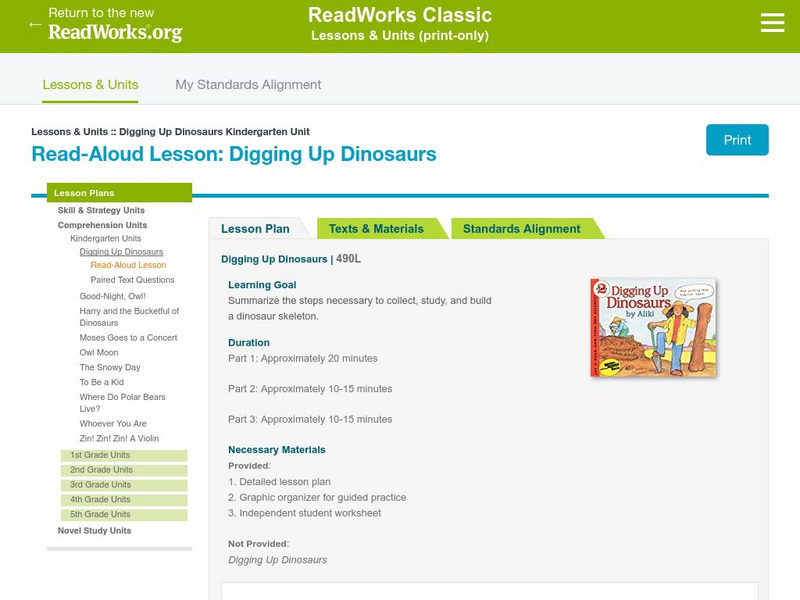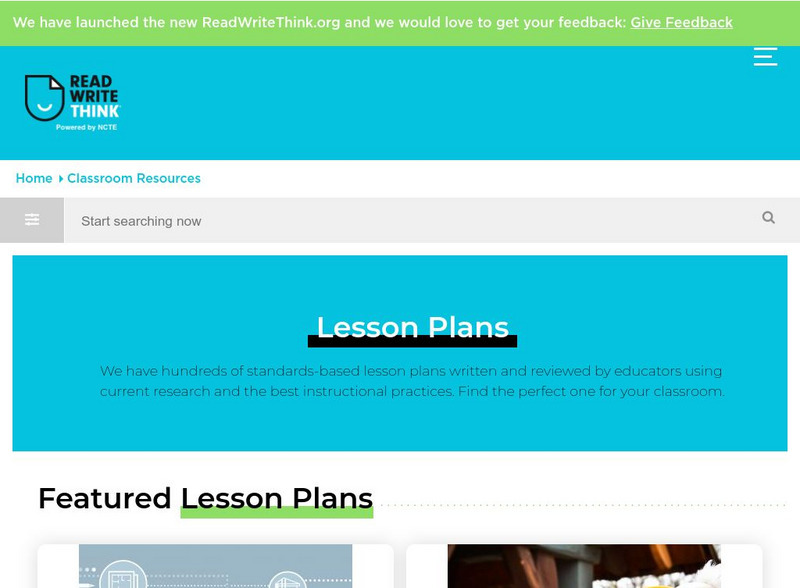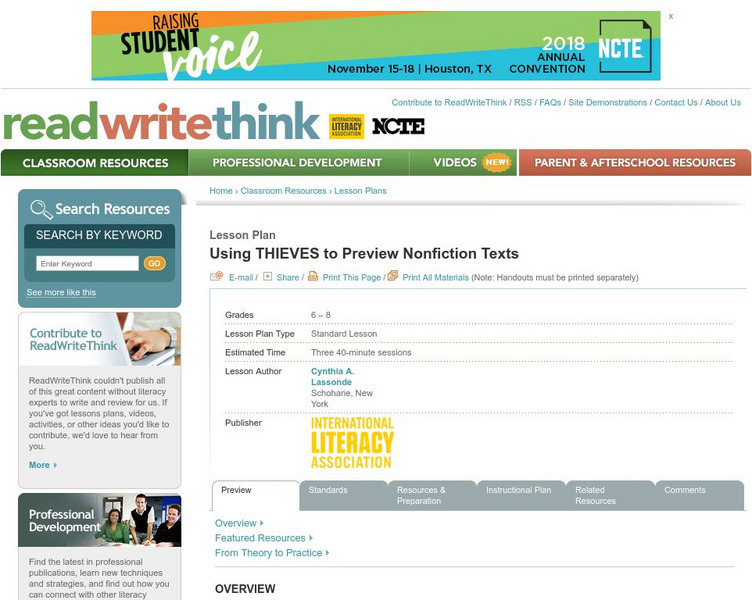New York State Education Department
TASC Transition Curriculum: Workshop 11
You'll C-E-R a difference in classroom achievement after using a helpful lesson. Designed for economics, civics, government, and US history classes, participants practice using the CER model to craft arguments about primary and secondary...
EngageNY
TASC Transition Curriculum: Workshop 15
What do a cheetah, Audi commercial, and air have in common? They're all topics of an engaging inquiry-based, hands-on workshop for educators about background knowledge, reading strategies, the CER model, and argumentative writing. The...
EngageNY
TASC Transition Curriculum: Workshop 6
Is a college education necessary for success in today's world? The class investigates the question, along with others at the end of the sixth workshop in a 15-part series. The lesson has four parts with multiple activities and...
Transforming Education
Self-Efficacy Strategies
Scholars with high levels of self-efficacy perform better in school. Instructors review a list of strategies for enhancing self-efficacy skills. They discover how to teach learners to appropriately define success, celebrate progress, and...
New York State Education Department
TASC Transition Curriculum: Workshop 4
Why is it important to use precise language? Participants explore this question in the fourth activity in a series of 15 on effective instruction. Perfect for all content areas, the activity promotes appropriate language choice through...
New York State Education Department
TASC Transition Curriculum: Workshop 13
The six instructional shifts in this workshop definitely move math and science teachers' understanding of instruction. The workshop, 13th out of a series of 15, asks participants to examine sample tests and to look at how the six...
EngageNY
TASC Transition Curriculum: Workshop 12
How can opinions slant facts? Workshop participants learn how to examine primary and secondary sources and identify the author's point of view. They also examine how visual art impacts the meaning and rhetoric of sources. Full of...
New York State Education Department
TASC Transition Curriculum: Workshop 5
Are video games sports? Pupils investigate this question as well as various nonfiction selections to learn more about claims and the support that defines them. All of the selections mimic the rigor on state tests and encourage close...
Transforming Education
Self-Management Strategies
What self-management techniques help scholars achieve their goals? Readers review a list of strategies for managing stress, increasing motivation, and setting goals. They discover how to monitor their emotions, create checklists to stay...
New York State Education Department
TASC Transition Curriculum: Workshop 10
How have educational standards evolved? Educators of adults examine expectations in the 10th workshop out of 15 to better determine how standards have grown. Participants respond to a variety of sample questions to determine how they...
Read Works
Read Works: Read Aloud Lesson: Whoever You Are
In this read-aloud lesson, students will identify similarities among people around the world in order to determine the theme of the story. Included is a detailed lesson plan, graphic organizer for guided practice, and an independent...
Read Works
Read Works: Lesson: Author's Purpose: Cause and Effect Signal Words
[Free Registration/Login Required] With this lesson plan, students can learn how several authors can write about the same topic, but for different purposes.
Read Works
Readworks: Read Aloud Lesson: Stellaluna
Compare Stellaluna's experience of living like a bird with her experience of living like a bat. Included in this instructional activity are a detailed lesson plan, a graphic organizer, and a student worksheet.
Read Works
Read Works: Read Aloud Lesson: Where Do Polar Bears Live?
This activity is a close reading of "Where Do Polar Bears Live?". After reading the book to the class, students will be able to identify and recall characteristics that allow polar bears to survive in an extremely cold Arctic...
Read Works
Read Works: Read Aloud Lesson: Digging Up Dinosaurs
[Free Registration/Login Required] Teachers will read "Digging Up Dinosaurs" using the close reading technique. Learners will use graphic organizers to summarize the steps necessary to collect, study, and build a dinosaur skeleton.
National Endowment for the Arts
National Endowment for the Arts: The Big Read: A Lesson Before Dying
Guide to Ernest J. Gaines' novel, A Lesson Before Dying, with historical information, author biography, discussion questions, and ten lesson plans with activities, homework assignments, project ideas and essay topics. A radio show, with...
ReadWriteThink
Read Write Think: Classroom Resources: Lesson Plans
Literacy lesson plans, mini-lessons, or units searchable by grade level, objective, or theme.
Read Works
Read Works: 3rd Grade: Lesson: Identifying Descriptive Language
[Free Registration/Login Required] With this lesson plan, 3rd graders can learn to identify descriptive language. Focused on the book "Mr. George Baker."
Read Works
Read Works: 3rd Grade: Author's Purpose: Lesson 2
[Free Registration/Login Required] This lesson plan helps students learn to identify an author's purpose.
ReadWriteThink
Read Write Think: Using Thieves to Preview Nonfiction Texts
Contains plans for three lessons that introduce a nonfiction prereading strategy with the acronym THIEVES, which stands for Title, Headings, Introduction, Every first sentence, Visuals and vocabulary, End Questions, and Summary. In...
ReadWriteThink
Read Write Think: Visualizing Using the Sketch to Stretch Strategy
Contains plans for three lessons to improve reading comprehension using a visualizing strategy called sketch-to-stretch. In addition to objectives and standards, this instructional plan contains links to sites used in the lessons as well...
ReadWriteThink
Read Write Think: Charting Characters for a More Complete Understanding
Contains plans for one 60-minute lesson that teaches about a reading strategy called Character Perspective Charting. In addition to student objectives and standards, these instructional plans contains links to PDF handouts and links to...
ReadWriteThink
Read Write Think: Word Recognition Strategies Using Nursery Rhymes
This lesson is a great way to teach students about rhymes and word recognition. This plan includes suggest nursery rhymes for you to use, and several supplementary sites to help you out.
ReadWriteThink
Read Write Think: Lesson Plan: Environmental Print
This instructional activity introduces students to the concept of reading through common items from the community. Through examining these items (environmental print), students will practice their reading skills and begin to see...























